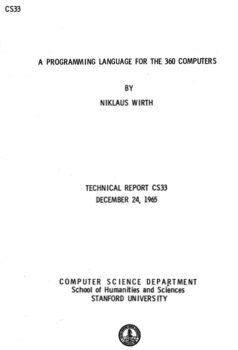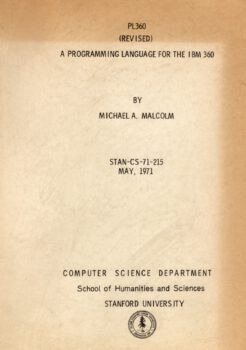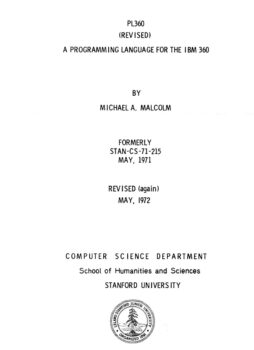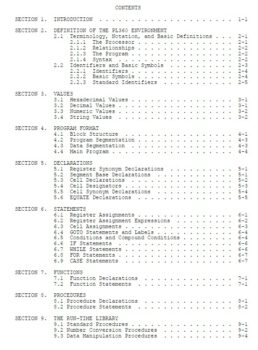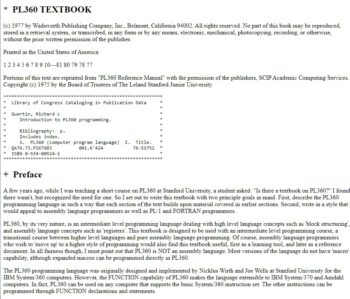PL360 (or PL/360) is a system programming language designed by Niklaus Wirth and written by Niklaus Wirth, Joseph W. Wells, Jr., and Edwin Satterthwaite, Jr. for the IBM System/360 computer at Stanford University. A description of PL360 was published in early 1968.
Niklaus Wirth in 1966 wanted to have a compiler written for his new Algol W language and the choices of programming language with which to write the compiler were FORTRAN and assembler language Wirth set aside the Algol W project temporarily and developed a programming language which was specifically designed for writing system-level software on an IBM 360 system. This systems programming language, the very first systems programming language other than assembler language, came to be known as PL360 (the name is sometimes written as PL/360 although it seems pretty clear that Wirth called it PL360 – I’m not 100% sure of this so please correct me if I’m wrong).
In practical terms, PL360 isn’t much more than an assembly language dressed up in fancy clothes (strictly speaking, it’s actually called a structured assembly language). Although a reasonable set of operators are defined, expression evaluation is strictly left to right and the programmer is responsible for managing the use of the machine registers and most aspects of memory management. In fact, it really wasn’t possible to write a PL360 program without quite intimate knowledge of the System/360 architecture.
The result is a language which requires considerable care and attention on the part of the programmer. Although friendlier than an actual assembler language, the inattentive programmer is provided with plenty of potential learning opportunities (i.e. pitfalls). For example, consider the following two statements:
R1 := R1 + R2;
R1 := R2 + R1;
Although these may appear to be equivalent, they are actually VERY different. The first statement adds machine register R2 to the contents of register R1 and stores the result in R1 (i.e. it adds R1 and R2 together and stores the result in R1). The second statement is actually equivalent to:
R1 := R2; R1 := R1 + R1;
i.e. it effectively computes 2*R2 and stores the result in R1.
PL360 ends up looking pretty sad if it is considered as a high-level programming language. On the other hand, if viewed as a mid to low-level language (i.e. an assembler language in fancy clothes) then it was actually quite respectable for the era. In fact, since the goal was to create a language which could be used to do systems programming, the necessity to understand the underlying architecture in detail was arguably a language feature rather than a failing.
By 1968, a compiler had been written for the PL360 language and Wirth was able to get on with the task of getting an Algol W compiler written. The ability to write systems programming level software using reasonably conventional looking statements and expressions turned out to be quite useful and PL360 went on to be used for a variety of projects.
PL/360 is a one pass compiler with a syntax similar to Algol that provides facilities for specifying exact machine language instructions and registers similar to assembly language, but also provides features commonly found in high-level languages, such as complex arithmetic expressions and control structures. Wirth used PL360 to create Algol W.
Data types are:
- Byte or character – a single byte.
- Short integer – 2 bytes, interpreted as an integer in two’s complement binary notation.
- Integer or logical – 4 bytes, interpreted as an integer in two’s complement binary notation.
- Real – 4 bytes, interpreted as a base-16 short floating-point number.
- Long real – 8 bytes, interpreted as a base-16 long floating-point number.
- Registers can contain integer, real, or long real.
-
Individual System/360 instructions can be generated inline using the PL360 “function statement” that defined an instruction by format and operation code. Function arguments were assigned sequentially to fields in the instruction.
From the CS33 Stanford University Report: A Programming Language for the 36O Computers, Niklaus Wirth, Introduction
This paper is a preliminary definition of a programming language which is specifically designed for use on IBM 360 computers, and is therefore appropriately called PL36O.
The intention is to present a programming tool which (a) closely reflects the particular structure of the 36O computer, and (b) is a superior notation to present Assembly Codes with respect to presentation and documentation of algorithms. As a consequence of (a), it enables a programmer to design programs mentioning explicitly features of this machine in a degree impossible in “higher level” languages.
It is also felt that a highly structured language is most appropriate (a) to promote the intelligibility of texts for the human user and (b) to encourage this user to properly structure his algorithms not on paper only, but in his mind as well. The language is therefore a phrase structure language containing many constructions which quite obviously correspond to a single 36O machine instruction (cf, [l]).
Moreover, it is hoped that through certain conventions (not mentioned in this preliminary paper) concerning the use of general registers as base address registers, programs written in PL36O can be efficiently run under a time-sharing monitor without requiring the presence of additional sophisticated relocation hardware (Model 67)°
Presently, a compiler for PL36O is available on the B55OO computer
This compiler is mainly intended to serve as a temporary tool for a bootstrapping process: The compiler is being rewritten in its own language and then becomes automatically available on the 36O computer. Indeed, the primary purpose of this project is to obtain a convenient tool for the development of other compilers (in particular ALGOL X) and monitor systems, where a considerable degree of machine-orientation and -dependence is desirable, but where an adequate standard of program documentation is of no less importance.
Documents for download:

